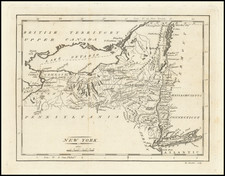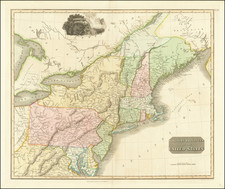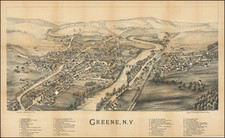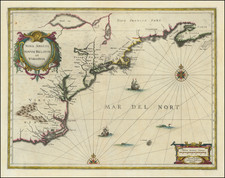Colonial New York Deed and Map on Vellum
Dividing up 10,000 acres of the Province of New York in 1773
An impressive and large manuscript deed on vellum, for a vast 10,000-acre tract of land in Charlotte County, New York. The deed is signed by both John Morin Scott and John Tabor Kempe, two prominent lawyers who would soon be on opposing sides of the American Revolution. The deed has a detailed manuscript map on a separate (attached) sheet of vellum.
The text of the deed mentions several prominent names, including Whitehead Hicks, 42nd Mayor of New York City (1766 to 1776), the first mayor to be born in what is now Queens:
This Indenture, made the nineteenth day of July in the year...1773, between John Tabor Kempe of the City of New York...and John Morin Scott of the same City...His present Majesty King George the Third by Letters Patent under the Great Seal of the Province in New York...ratify and confirm unto the said John Tabor Kempe and John Morin Scott, and unto Elizabeth Kempe, Philadelphia Kempe, Whitehead Hicks, John Woods, Samuel Jones, Adrian Rutgers, Adrian Renaudet, James Emott, Richard Sharpe, Benjamin Sharpe, Benjamin Hissam, John Bard, William Webb, Abraham Cock, Bernard Lintot, and Thomas Frost, all that certain Tract or Parcel of Land Situate lying and being in the County of Albany on the East Side of the Hudson's River to the Eastward of Fort Edward...
The Map
The finely drawn pen & ink map depicts the land neatly subdivided into 45 numbered square tracts, with each square containing the initials of the respective owner (I.T.K. for Kempe or I.M.S. for Scott). Numerous trees are noted, including beeches, maples, a black birch, a hemlock, an elm, and "a dry ash tree marked no. 1 on two sides. This tree is also marked No. XX on two sides." Several unidentified rivers are shown, as well as two lakes.
Charlotte County, Later Washington County
Charlotte County, created only a year before the present deed was executed, was carved out of massive Albany County, and named for Charlotte of Mecklenburg-Strelitz, wife of King George III. In 1784 it was renamed Washington County, in honor of George Washington. The county was very large with its western boundary running from the northern boundary of Albany County to the border with Canada. Its southern boundary was what is now the northern boundary of Saratoga County. It also included much of western Vermont. When, in 1777, the Vermont Republic voiced claims to the eastern section of Charlotte County, New York's state legislature responded by vote on April 2, 1784, changing the name of Charlotte County to Washington County, declaring: “From and after the passing of this act, the county of Tyron shall be called and known by the name of Montgomery, and the county of Charlotte by the name of Washington.” However, in 1791, when Vermont became a state, it recouped the disputed section of Charlotte County.
Scott and Kempe
John Morin Scott, a prominent Manhattan native who served as an officer in George Washington's Continental Army during the New York and New Jersey campaign of the American Revolution. He fought at the Battle of Brooklyn and was reputedly the last to argue against the surrender of Manhattan to the British - likely due to his land holdings there. In 1777 he was elected to the New York Senate and served as New York Secretary of State in 1778. A graduate of Yale, he was admitted to the New York bar in 1752. Before the Revolution he railed against the Stamp Act in a piece of writing signed under the name of “Freeman.”
John Tabor Kempe, also a lawyer, was the son of colonial New York Attorney General William Kempe, who arrived in the province from England in 1752. When the elder Kempe died in 1759, John Tabor Kempe was appointed Attorney General of New York. Through marriage Kempe became one of the largest land owners in the Province. A Loyalist, he remained in New York during the Revolution, but was later accused of treason and his properties were confiscated. He returned to his native England and died there in 1792.
In 1825, Kempe’s heirs got a bill passed by the New York Legislature that restored to them his house, stables and grounds on the northeast of Greenwich Street in New York City.













![[ St. Lawerence River / Lake Champlain ] Carte Du Cours Du Fleuve De St. Laurent Depuis son Embouchere jusqu'au dessus de Quebec . . .](https://storage.googleapis.com/raremaps/img/small/101652.jpg)


